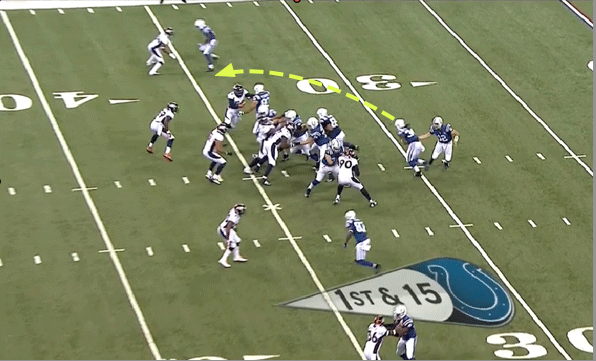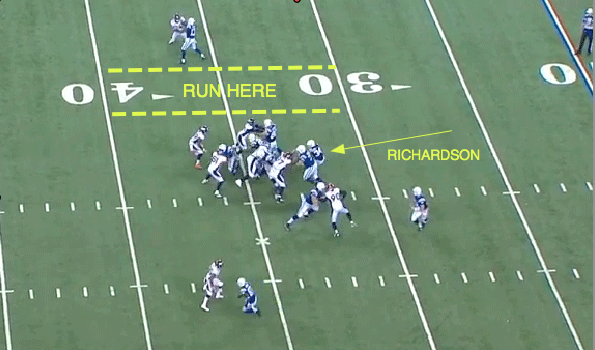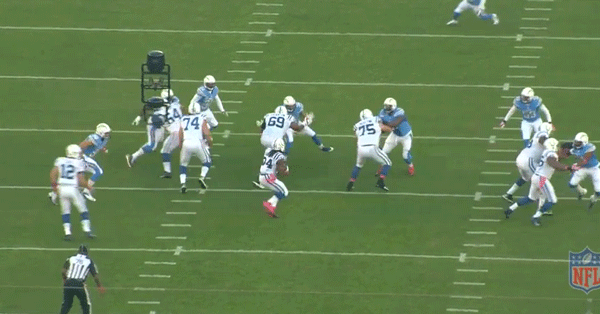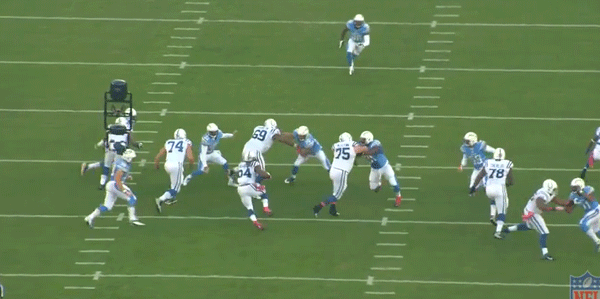You are using an out of date browser. It may not display this or other websites correctly.
You should upgrade or use an alternative browser.
You should upgrade or use an alternative browser.
Trent Richardson Released
- Thread starter Miller
- Start date
xwalker
Well-Known Member
- Messages
- 57,202
- Reaction score
- 64,709

@rand_getlin
The #Colts announce they have waived RB Trent Richardson.
4:10pm - 12 Mar 15
Anyone can run behind our line...
He was released but was only wondering how many people would enter here with steam in their eyes saying" No"
His issue is primarily mental/work-ethic. I could see him getting his act together at some point, especially if he only gets veteran's minimum offers.
SilverStarCowboy
The Actualist
- Messages
- 10,337
- Reaction score
- 1,998
Rather sign McFadden if we're signing duds.
No problem with either one. Vet Min signings to compete as a #2 back.
speedkilz88
Well-Known Member
- Messages
- 36,953
- Reaction score
- 23,101
The Deep Post: Why Is Trent Richardson Struggling so Mightily with the Colts?
Blockbuster trades are rare in the NFL, which is why when the Indianapolis Colts sent a first-round draft pick to the Cleveland Browns for running back Trent Richardson, the NFL media went crazy.
Richardson, a player many (myself included) called the best running back we had scouted, was now paired with best-ever prospect Andrew Luck? Let the craziness ensue.
But it hasn't.
Instead of seeing the No. 1 and No. 3 overall picks from the 2012 NFL draft dominate together, Richardson has struggled to produce in an offense that admittedly wants to be a power-run team. So what gives? Why is Richardson, who was an elite prospect at Alabama, struggling to find rushing lanes?
Taking a look at Richardson's scouting report prior to the 2012 draft and his play now, we can start to chip away at the reasons for his lack of success in Indianapolis.
Speed
Then
Richardson shows ideal ability in getting to the outside. His patience from the handoff is key, as he waits for his blocks to develop. Once Richardson gets to the end of the offensive line, he changes gears and explodes to the end zone.This is a perfect example of being patient but having the speed to accelerate to the opening.
Now
The biggest difference I see between the 2011 college football season and today is a lack of speed, burst and violence when running the football.
Richardson was renowned for his ability to see the hole and explode into top speed. His combination of size, strength and burst is what made him such an elite draft prospect. Today, Richardson tends to tiptoe or stutter-step before attacking a hole. As my high school football coach so often accused me of doing, Richardson is "tiptoeing through the tulips" instead of just hitting the hole.
Vision
Then
Richardson executes perfectly here. Watch as he starts out running parallel to the offensive line, toward the sideline. Before getting to the hash marks, he sees an opening up-field and takes it. This is picture-perfect play and what every scout hopes for in a running back.
Now
Richardson looked like a future All-Pro at Alabama, but in the NFL, he's struggling to find rushing lanes. This could be from a lack of understanding the scheme, poor field vision or just missed opportunities. To me, it looks like paralysis-by-analysis.

Here, we see Richardson taking a handoff in the backfield. He has the left guard pulling, the tight end sealing the defensive end and a clear rushing lane off tackle with just the middle linebacker flowing across the formation to worry about. You see the rushing lane. I see the rushing lane. Richardson does not see the rushing lane.

Instead of bouncing this play outside, Richardson goes with the called play and turns upfield off the right guard's block. We know this is the called play because the right guard has stepped inside to block the defensive tackle, while the right tackle and tight end are sealing off an opening. Only they didn't seal it, and there is no hole. But Richardson still goes there, ignoring the tractor-trailer-sized hole off tackle.
My take: Richardson is running to the designed or called hole instead of seeing the field and attacking openings. He's overthinking the play, and is handcuffing himself by doing so. By getting back to his roots and trusting his instincts, Richardson can start producing again.
Strength
[/video]
Then
Here we see Richardson take a normal inside handoff, but watch as he breaks the tackle of a defensive tackle in the backfield and then pushes the pile for extra yardage. This is the type of run scouts want to see to judge a player's ability in short-yardage and goal-line situations.
Now
It's easy to dismiss Richardson as having lost the strength for which he was notorious during his college days, especially if you're just casually watching a game. Actually digging in and looking at Richardson's play with the Colts, you'll notice that he's breaking tackles and causing defenders to miss often.
Looking at other power runners in the NFL, Richardson stacks up quite well.
PlayerCarriesMissed TacklesCarries per MT
Trent Richardson 75 13 5.76
Adrian Peterson 115 25 4.6
Matt Forte 116 18 6.4
Frank Gore 127 12 10.5
LeSean McCoy 14 128 5.03
Marshawn Lynch 138 36 3.83
Pro Football Focus
The problem isn't that Richardson has lost his strength; it's that yardage after contact isn't there. In the games I charted, Richardson averaged two yards after contact. Defenders are hitting him early in the backfield, and Richardson may make the first one miss, but he's gang-tackled soon after.
Defenses are able to key on the run game and attack inside lanes—as that's the only place the Colts run the ball with Richardson in the game. This results in a back who is hit behind the line of scrimmage and struggles to break free after the fact.
The strength and power shown at Alabama are still there, but the tackling and speed of defenders in the NFL is so much better.
Footwork
Then
This is what an NFL running back should look like. Richardson has a wide base, does a great job changing direction and then runs with power and speed when picking his hole. The ability to get through traffic on this play and pick up positive yardage is a great indicator of why Richardson is the No. 1 back in the country.
Now
The wide base and powerful running are still there, but gone are the huge inside rushing lanes Richardson saw at Alabama. Now, he's dealing with narrowing holes and defenders smart enough to play their gap and close off cutback lanes.

Against San Diego, Richardson takes an inside handoff and meets resistance. His center and both guards are locked one-on-one with defenders, but all have allowed their man enough mobility to make a potential tackle. The right tackle has kicked out and left an outside linebacker standing just off the B-gap, which eliminates that opening.

Richardson does what a good back would in this situation—he tries to cut back and follow the left tackle, Anthony Castonzo (No. 74), upfield. This requires some old-school Richardson footwork, and he executes the cutback quickly and with good balance. The downside is that there is no opening.
Castonzo gets to the second level a step late and doesn't seal off the defender waiting in the hole. On the backside, where Richardson was originally, right tackle Gosder Cherilus still hasn't reached the outside linebacker (No. 53), which means that side wasn't a better option for Richardson.
All too often, this is the theme with Richardson running the ball. His linemen can hold blocks for a second, but not long enough to let him sift through traffic and find a rushing lane. Especially when running inside behind guards Hugh Thornton and Mike McGlynn.
Why does Donald Brown have better luck running behind the same line? Because he's faster, and is able to make a quicker cut while the linemen have their defenders engaged. It's easier to be a scatback behind a line that can engage defenders but struggles to control them.

Then vs. Now
The biggest difference in Richardson's game is that lack of anger that he ran with at Alabama. It's possible that he's overthinking and trying to analyze the field instead of reacting to it. It's also possible that subpar run-blocking has been at least partly responsible for his dip in production, and the film certainly backs up this theory.
It's conceivable that Richardson was in a perfect situation at Alabama, too. He ran behind an offensive line featuring three current NFL players (Barrett Jones, Chance Warmack and D.J. Fluker) and a current first-round draft prospect (Cyrus Kouandjio). The line at Alabama was otherworldly, and the line in Indianapolis isn't. The holes Richardson ran through at Alabama are now cracks and creases.Adjusting to the NFL is tough for every young player, but for Richardson to succeed, he has to start attacking openings, trusting his blockers and running with the aggression that made him a star in Tuscaloosa.
http://bleacherreport.com/articles/...hardson-struggling-so-mightily-with-the-colts
Blockbuster trades are rare in the NFL, which is why when the Indianapolis Colts sent a first-round draft pick to the Cleveland Browns for running back Trent Richardson, the NFL media went crazy.
Richardson, a player many (myself included) called the best running back we had scouted, was now paired with best-ever prospect Andrew Luck? Let the craziness ensue.
But it hasn't.
Instead of seeing the No. 1 and No. 3 overall picks from the 2012 NFL draft dominate together, Richardson has struggled to produce in an offense that admittedly wants to be a power-run team. So what gives? Why is Richardson, who was an elite prospect at Alabama, struggling to find rushing lanes?
Taking a look at Richardson's scouting report prior to the 2012 draft and his play now, we can start to chip away at the reasons for his lack of success in Indianapolis.
Speed
[/video]
Then
Richardson shows ideal ability in getting to the outside. His patience from the handoff is key, as he waits for his blocks to develop. Once Richardson gets to the end of the offensive line, he changes gears and explodes to the end zone.This is a perfect example of being patient but having the speed to accelerate to the opening.
Now
The biggest difference I see between the 2011 college football season and today is a lack of speed, burst and violence when running the football.
Richardson was renowned for his ability to see the hole and explode into top speed. His combination of size, strength and burst is what made him such an elite draft prospect. Today, Richardson tends to tiptoe or stutter-step before attacking a hole. As my high school football coach so often accused me of doing, Richardson is "tiptoeing through the tulips" instead of just hitting the hole.
Vision
[/video]
Then
Richardson executes perfectly here. Watch as he starts out running parallel to the offensive line, toward the sideline. Before getting to the hash marks, he sees an opening up-field and takes it. This is picture-perfect play and what every scout hopes for in a running back.
Now
Richardson looked like a future All-Pro at Alabama, but in the NFL, he's struggling to find rushing lanes. This could be from a lack of understanding the scheme, poor field vision or just missed opportunities. To me, it looks like paralysis-by-analysis.

Here, we see Richardson taking a handoff in the backfield. He has the left guard pulling, the tight end sealing the defensive end and a clear rushing lane off tackle with just the middle linebacker flowing across the formation to worry about. You see the rushing lane. I see the rushing lane. Richardson does not see the rushing lane.

Instead of bouncing this play outside, Richardson goes with the called play and turns upfield off the right guard's block. We know this is the called play because the right guard has stepped inside to block the defensive tackle, while the right tackle and tight end are sealing off an opening. Only they didn't seal it, and there is no hole. But Richardson still goes there, ignoring the tractor-trailer-sized hole off tackle.
My take: Richardson is running to the designed or called hole instead of seeing the field and attacking openings. He's overthinking the play, and is handcuffing himself by doing so. By getting back to his roots and trusting his instincts, Richardson can start producing again.
Strength
[/video]
Then
Here we see Richardson take a normal inside handoff, but watch as he breaks the tackle of a defensive tackle in the backfield and then pushes the pile for extra yardage. This is the type of run scouts want to see to judge a player's ability in short-yardage and goal-line situations.
Now
It's easy to dismiss Richardson as having lost the strength for which he was notorious during his college days, especially if you're just casually watching a game. Actually digging in and looking at Richardson's play with the Colts, you'll notice that he's breaking tackles and causing defenders to miss often.
Looking at other power runners in the NFL, Richardson stacks up quite well.
PlayerCarriesMissed TacklesCarries per MT
Trent Richardson 75 13 5.76
Adrian Peterson 115 25 4.6
Matt Forte 116 18 6.4
Frank Gore 127 12 10.5
LeSean McCoy 14 128 5.03
Marshawn Lynch 138 36 3.83
Pro Football Focus
The problem isn't that Richardson has lost his strength; it's that yardage after contact isn't there. In the games I charted, Richardson averaged two yards after contact. Defenders are hitting him early in the backfield, and Richardson may make the first one miss, but he's gang-tackled soon after.
Defenses are able to key on the run game and attack inside lanes—as that's the only place the Colts run the ball with Richardson in the game. This results in a back who is hit behind the line of scrimmage and struggles to break free after the fact.
The strength and power shown at Alabama are still there, but the tackling and speed of defenders in the NFL is so much better.
Footwork
[/video]
Then
This is what an NFL running back should look like. Richardson has a wide base, does a great job changing direction and then runs with power and speed when picking his hole. The ability to get through traffic on this play and pick up positive yardage is a great indicator of why Richardson is the No. 1 back in the country.
Now
The wide base and powerful running are still there, but gone are the huge inside rushing lanes Richardson saw at Alabama. Now, he's dealing with narrowing holes and defenders smart enough to play their gap and close off cutback lanes.

Against San Diego, Richardson takes an inside handoff and meets resistance. His center and both guards are locked one-on-one with defenders, but all have allowed their man enough mobility to make a potential tackle. The right tackle has kicked out and left an outside linebacker standing just off the B-gap, which eliminates that opening.

Richardson does what a good back would in this situation—he tries to cut back and follow the left tackle, Anthony Castonzo (No. 74), upfield. This requires some old-school Richardson footwork, and he executes the cutback quickly and with good balance. The downside is that there is no opening.
Castonzo gets to the second level a step late and doesn't seal off the defender waiting in the hole. On the backside, where Richardson was originally, right tackle Gosder Cherilus still hasn't reached the outside linebacker (No. 53), which means that side wasn't a better option for Richardson.
All too often, this is the theme with Richardson running the ball. His linemen can hold blocks for a second, but not long enough to let him sift through traffic and find a rushing lane. Especially when running inside behind guards Hugh Thornton and Mike McGlynn.
Why does Donald Brown have better luck running behind the same line? Because he's faster, and is able to make a quicker cut while the linemen have their defenders engaged. It's easier to be a scatback behind a line that can engage defenders but struggles to control them.

Then vs. Now
The biggest difference in Richardson's game is that lack of anger that he ran with at Alabama. It's possible that he's overthinking and trying to analyze the field instead of reacting to it. It's also possible that subpar run-blocking has been at least partly responsible for his dip in production, and the film certainly backs up this theory.
It's conceivable that Richardson was in a perfect situation at Alabama, too. He ran behind an offensive line featuring three current NFL players (Barrett Jones, Chance Warmack and D.J. Fluker) and a current first-round draft prospect (Cyrus Kouandjio). The line at Alabama was otherworldly, and the line in Indianapolis isn't. The holes Richardson ran through at Alabama are now cracks and creases.Adjusting to the NFL is tough for every young player, but for Richardson to succeed, he has to start attacking openings, trusting his blockers and running with the aggression that made him a star in Tuscaloosa.
http://bleacherreport.com/articles/...hardson-struggling-so-mightily-with-the-colts
coogrfan
Well-Known Member
- Messages
- 3,107
- Reaction score
- 1,666
I just don't know why not...even though his growth has stunted, he's as solid a #2 as they come...not sure you can say that about Randall and Dunbar.
How about no?
Hoofbite
Well-Known Member
- Messages
- 40,871
- Reaction score
- 11,570
i seriously doubt anyone signs him.
If his pro performance was used to project him as a player in the draft, he'd go undrafted. He's been awful.
LatinMind
iPhotoshop
- Messages
- 17,458
- Reaction score
- 11,571
@rand_getlin
The #Colts announce they have waived RB Trent Richardson.
4:10pm - 12 Mar 15
Anyone can run behind our line...
He was released but was only wondering how many people would enter here with steam in their eyes saying" No"
Don't be suprised to see a move like this
Bleu Star
Bye Felicia!
- Messages
- 33,925
- Reaction score
- 19,920
I'd rather sign Icky Woods. At least we would have cold cuts.
/thread
Lol
- Messages
- 101,918
- Reaction score
- 112,945

I'd rather sign Icky Woods. At least we would have cold cuts.
Gonna get some cold cuts today!
Texan_Eph89
Well-Known Member
- Messages
- 1,094
- Reaction score
- 61
For dirt cheap, sure. His play is worth a veteran minimum but little more.
Frosty
Bigdog24
- Messages
- 3,960
- Reaction score
- 2,257
Camp body. Why not
Bingo,,,,,,give him a show me contract....prove it in camp or send him out the door
coogrfan
Well-Known Member
- Messages
- 3,107
- Reaction score
- 1,666
For dirt cheap, sure. His play is worth a veteran minimum but little more.
This is the same sort of logic that saddled us with Brandon Weeden.
PA Cowboy Fan
Well-Known Member
- Messages
- 25,354
- Reaction score
- 51,350
This is the same sort of logic that saddled us with Brandon Weeden.
I was thinking the same thing. Can you picture a game where Weeden is handing off the ball to Richardson? We'd be the laughingstock of the league.
manster4ever
Well-Known Member
- Messages
- 5,021
- Reaction score
- 3,378
Bring him in for $3M and replace Randal...
THREE mil? LOL man. HELL no....it's funny you mention 3 mil. He claims that's how much Indy owes him after they suspended him for being a lazy tool. This guy is poison. Read this article boys and tell me you still want to 'take a flyer' on him. No way:
http://espn.go.com/nfl/story/_/id/1...colts-waive-disappointing-rb-trent-richardson
speedkilz88
Well-Known Member
- Messages
- 36,953
- Reaction score
- 23,101
They suspended from missing a team flight because his wife had emergency pregnancy complications. Would you walk away from 3 million that was guaranteed and that was the reason?THREE mil? LOL man. HELL no....it's funny you mention 3 mil. He claims that's how much Indy owes him after they suspended him for being a lazy tool. This guy is poison. Read this article boys and tell me you still want to 'take a flyer' on him. No way:
http://espn.go.com/nfl/story/_/id/1...colts-waive-disappointing-rb-trent-richardson

